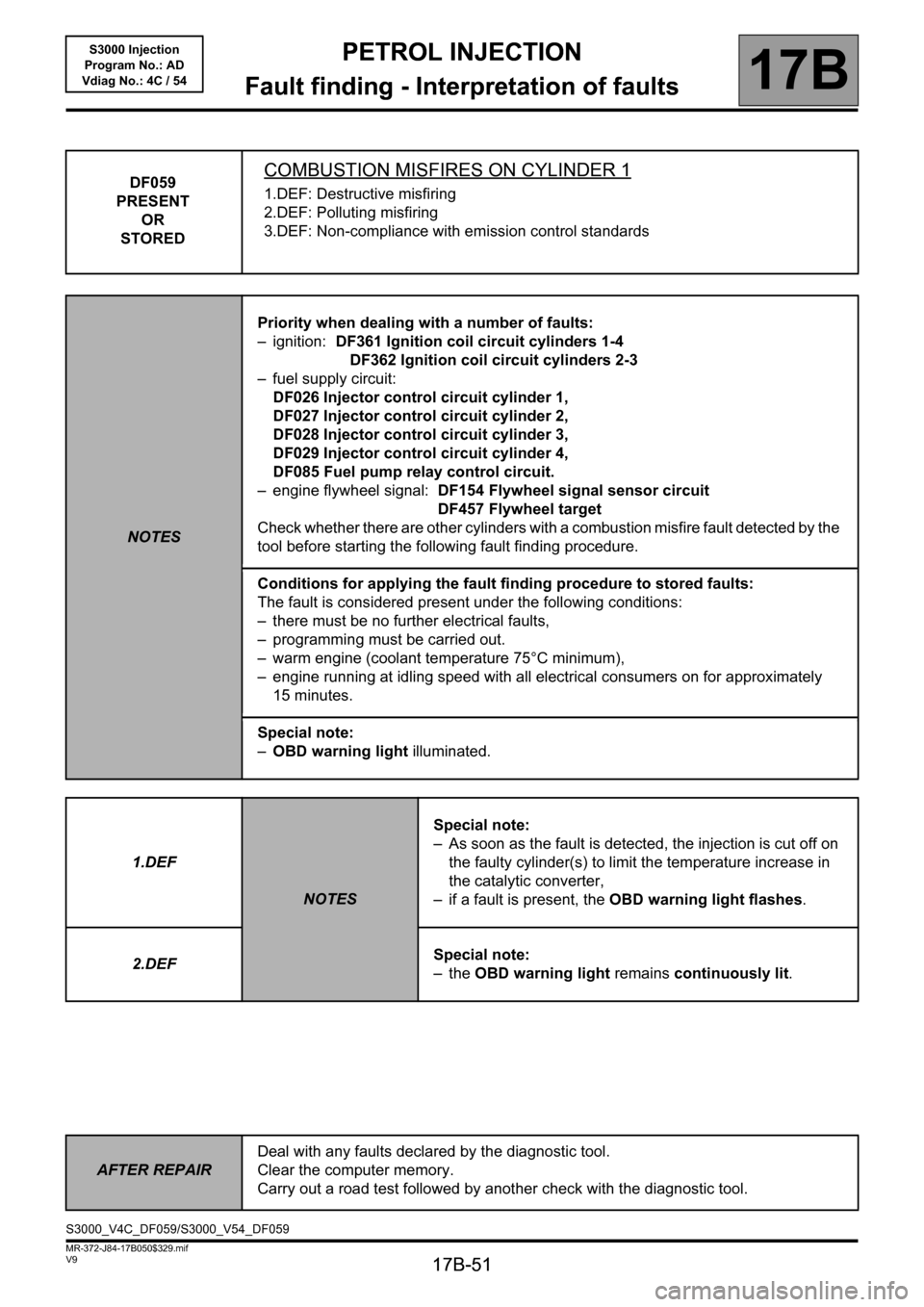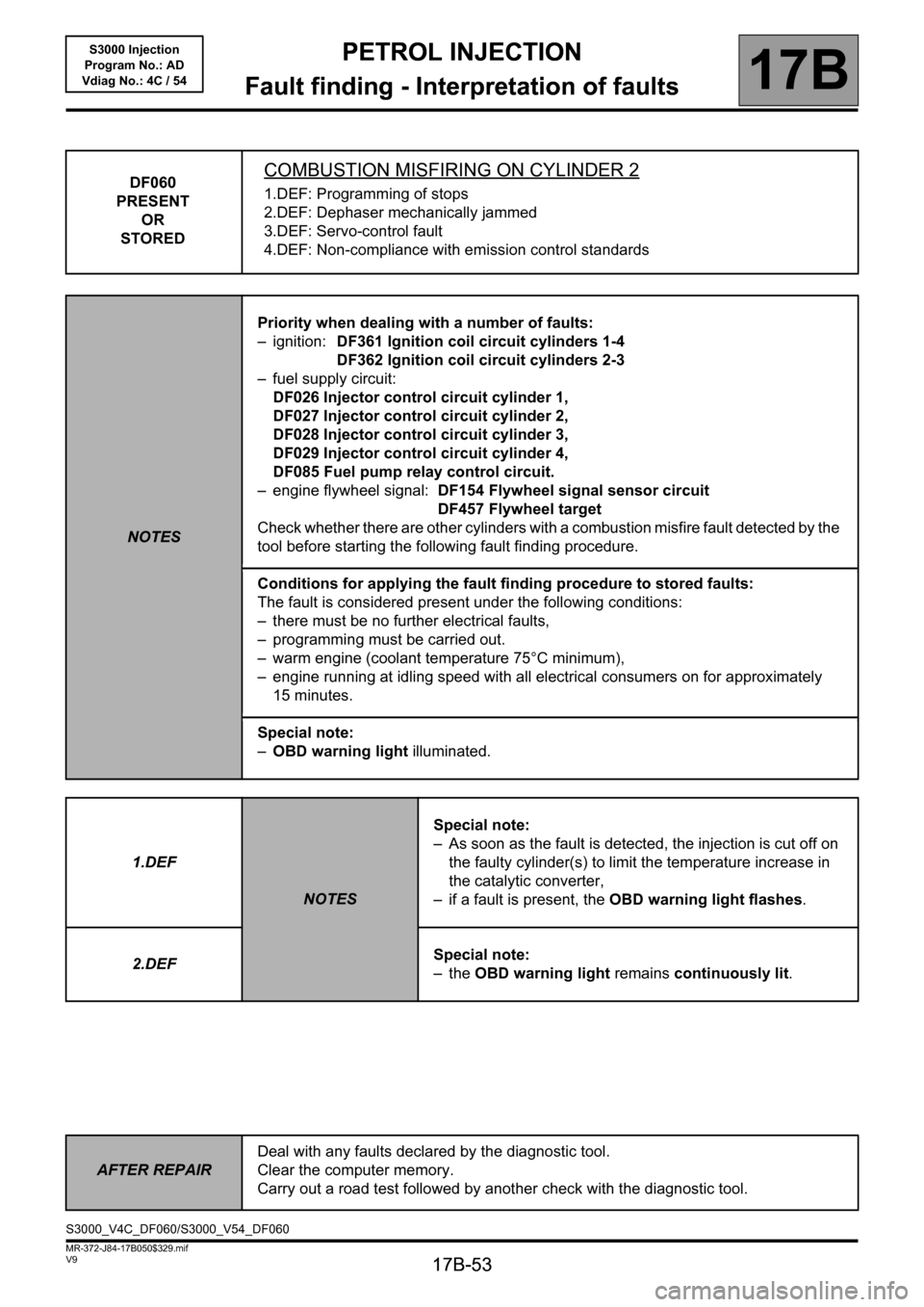oil RENAULT SCENIC 2010 J95 / 3.G Petrol Injection S3000 Injection Workshop Manual
[x] Cancel search | Manufacturer: RENAULT, Model Year: 2010, Model line: SCENIC, Model: RENAULT SCENIC 2010 J95 / 3.GPages: 230, PDF Size: 0.92 MB
Page 7 of 230

PETROL INJECTION
Fault finding - System operation
17B
17B - 7
PETROL INJECTION
Fault finding - System operation
17B
17B - 7V9 MR-372-J84-17B050$094.mif
S3000 Injection
Program No.: AD
Vdiag No.: 4C / 54PETROL INJECTION
Fault finding - System operation
1. SYSTEM OPERATION
Composition
The injection system consists of the:
– accelerator potentiometer,
– clutch pedal switch,
– TDC sensor,
– atmospheric pressure sensor,
– air temperature sensor,
– coolant temperature sensor,
– upstream oxygen sensor,
– downstream oxygen sensor,
– cruise control switch,
– steering column switch,
– cruise control on/off switch,
– fuel vapour absorber,
– injection computer,
– motorised throttle valve,
– 4 injectors,
– 4 pencil coils,
– pinking sensor,
– camshaft dephaser solenoid valve (non-LPG K4M only),
– camshaft position sensor (non-LPG K4M only),
– turbocharging pressure sensor (F4R turbo only)
– electric coolant pump (F4R turbo only),
– wastegate solenoid valve (only on F4R Turbo),
– turbocharging solenoid valve (only on F4R-Turbo)
Computer
128 track SAGEM type S3000 FLASH EEPROM computer controlling injection and ignition.
Multipoint injection in sequential mode.
Connections to the other computers:
– air conditioning,
– UCH,
– protection and switching unit (UPC)
– Automatic Gearbox Electronic Control Unit (AUTO).
– airbag,
– ABS/ESP,
– instrument panel.
MR-372-J84-17B050$094.mif
Page 11 of 230

PETROL INJECTION
Fault finding - System operation
17B
17B - 11
PETROL INJECTION
Fault finding - System operation
17B
17B - 11V9 MR-372-J84-17B050$094.mif
S3000 Injection
Program No.: AD
Vdiag No.: 4C / 54
Adaptive idling speed correction:
Under normal warm operating conditions, the idling speed opening cycle ratio value PR091 Idling speed regulation
theoretical OCR varies between a high value and a low value to obtain the nominal idling speed.
After operating dispersion (running in, engine fouling, etc.), the opening cycle ratio value may be close to the high or
low values.
The adaptive correction PR090 Idling speed regulation programming value on the idling speed opening cycle
ratio compensates for the gradual variations in the engine's air requirement, by bringing the idling speed opening
cycle ratio back to an average nominal value.
This adjustment only takes effect if the coolant temperature is above 75 °C, 1 minute after starting the engine and
during the idle speed regulation phase.
Idling speed setpoint calculation:
The idling speed setpoint is given by parameter PR010 Idle speed regulation valve setpoint.
The idling speed regulation setpoint depends on the coolant temperature, the depollution programming, the climate
control requirements, the position of the gearbox selector, any power assisted steering action, the passenger
compartment heating resistors, the oil temperature (engine protection) and the electricity balance calculated by the
injection software (the engine speed is increased by 160 rpm maximum if the battery voltage remains below 12.7 V).
Richness management
For optimal operation of the catalytic converter, the richness must be maintained around 1.
Richness regulation is controlled by the upstream sensor. The sensor gives voltage according to the difference
between the partial oxygen pressures contained in the exhaust and a cavity filled with a reference mixture
(atmosphere).
As the partial oxygen pressure in the exhaust is representative of the richness, the voltage supplied to the computer
represents a Rich - Lean signal.
Adaptive richness correction:
In loop mode, the richness regulation corrects the injection duration in order to obtain a mixture which is as close as
possible to a richness of 1. The richness correction value PR138 Richness correction is close to 50 %, with limits
of 0 and 100 %.
The richness adaptive corrections PR143 Self-adapting richness gain and PR144 Self-adapting richness offset
are used to offset the injection mapping to centre richness regulation on 50 %.
Adaptive corrections take 50 % as an average value after computer initialisation (clearing the programming) and have
the following limit values:
Page 14 of 230

PETROL INJECTION
Fault finding - System operation
17B
17B - 14
PETROL INJECTION
Fault finding - System operation
17B
17B - 14V9 MR-372-J84-17B050$094.mif
S3000 Injection
Program No.: AD
Vdiag No.: 4C / 54
3. OBD management
Managed OBD programming is as follows:
– catalytic converter operational fault finding,
– upstream oxygen sensor operational fault finding,
– misfiring fault finding with two levels of detection: pollutant misfiring and catalytic converter breakage
misfiring,
– fuel supply system fault finding.
The misfiring and fuel supply system fault finding is performed continuously.
The operational fault finding for the upstream sensor and the catalytic converter can be only be carried out once per
journey, and can never occur at the same time.
OBD fault manager:
The OBD faults manager does not replace or modify conventional electrical fault management. Perform to comply
with OBD standard.
The requirements are:
●storing OBD faults,
●illuminate the OBD warning light for all faults where the OBD emission thresholds are exceeded,
●flash the OBD warning light for misfire faults damaging the catalytic converter.
Operating principle.
If a fault is detected and confirmed during 3 consecutive journeys then:
●an OBD stored fault is raised,
●the OBD fault warning light receives a request to be lit continuously. This request is only recognised if the
fault in question is authorised to activate the OBD warning light.
To deactivate the warning light, no OBD faults should be detected for 3 consecutive journeys.
The electrical fault finding checks taken into consideration by the OBD faults manager are as follows:
– pressure,
– turbocharging pressure,
– coolant temperature,
– air temperature
– upstream sensor,
– downstream sensor,
– upstream sensor heating,
– downstream sensor heating,
–injector1,
–injector2,
–injector3,
–injector4,– ignition coil 1,
– ignition coil 2,
– ignition coil 3,
– ignition coil 4,
– petrol pump,
– wastegate,
– canister bleed,
– air line system,
– turbocharging system
– pinking sensor,
– camshaft dephaser.
Page 24 of 230

PETROL INJECTION
Fault finding - Allocation of computer tracks17B
17B - 24
17B
17B - 24V9 MR-372-J84-17B050$141.mif
S3000 Injection
Program No.: AD
Vdiag No.: 4C / 54
Connector (C), 48 tracks:
Track Description
A1 Not used
A2 Downstream oxygen sensor + signal
A3 Not used
A4 Not used
B1 Upstream oxygen sensor + signal
B2 Downstream oxygen sensor - signal
B3 Not used
B4 Not used
C1 Upstream oxygen sensor - signal
C2 Not used
C3 Not used
C4 Not used
D1 Ignition coils and petrol pump relay control
D2 Not used
D3 Not used
D4 Not used
E1 Canister bleed solenoid valve control
E2 Camshaft position sensor earth (non-LPG K4M only)
E3 Not used
E4 Not used
F1 Inlet camshaft input frequency sensor (non-LPG K4M only)
F2 Not used
F3 Not used
F4 Not used
G1 Not used
G2 Not used
G3 Not used
G4 Turbocharging solenoid valve control (F4RT 774, 776 only)
H1 Not used
H2 Not used
H3 Not used
H4 Not used
Page 25 of 230

PETROL INJECTION
Fault finding - Allocation of computer tracks17B
17B - 25
17B
17B - 25V9 MR-372-J84-17B050$141.mif
S3000 Injection
Program No.: AD
Vdiag No.: 4C / 54
Connector (C), 48 tracks (continued):
Track Description
J1 Not used
J2 Coolant thermostat control output
J3 Not used
J4 Not used
K1 Not used
K2 Not used
K3 Not used
K4 Not used
L1 Power earth 3
L2 Upstream oxygen sensor heating - control
L3 Downstream oxygen sensor heating - control
L4 Not used
M1 Power earth 4
M2 Not used
M3 Ignition coil 2 - 3 - control
M4 Ignition coil 1 - 4 - control
Page 32 of 230

PETROL INJECTION
Fault finding - Fault summary table
17B
17B-32
PETROL INJECTION
Fault finding - Fault summary table
17B
17B-32V9 MR-372-J84-17B050$282.mif
S3000 Injection
Program No.: AD
Vdiag No.: 4C / 54
Tool faultAssociated
DTC codeDescriptionLevel 2 fault
warning light
(Red brake
warning light)Level 1 fault
warning light
(Orange
injection
warning light)No warning
light onOBD
warning light
DF102 2502Signal: power sig.*
available1.DEF
DF105 0585Cruise control/
speed limiter on/off
circuit1.DEF
DF106 0575Cruise control/
speed limiter
function selectors
on steering wheel1.DEF
DF109 0313Low fuel level
misfiring1.DEF/
2.DEF/
3.DEF
DF119 0340Camshaft sensor
signal1.DEF/2.DEF/
3.DEF/4.DEF
DF126 1604Passenger
compartment
heating resistor
(RCH)1.DEF
DF138 0830 Clutch pedal switch 1.DEF
DF154 0335Flywheel signal
sensor circuit1.DEF/2.DEF/
3.DEF
DF196 0225Pedal sensor
circuit gang 11.DEF
CO/CC.0/
CC.1CO/CC.0/
CC.1
2.DEF
DF198 2120Pedal sensor
circuit gang 2CO
CC.0/ CC.1CO
CC.0/ CC.1
DF228 0504 Brake signal 1.DEF/2.DEF
DF232 0530Refrigerant
pressure sensor
circuit1.DEF
DF361 0351Ignition coil control
- cylinders 1 - 4CO.0/CC.1
1.DEFCO.0/CC.1
1.DEF
DF362 0352Ignition coil control
- cylinders 2 - 3CO.0/CC.1
1.DEFCO.0/CC.1
1.DEF
DF377 C115Petrol↔ LPG
connection1.DEF/2.DEF
DF394 0420Catalytic converter
operating fault1.DEF/
2.DEF
DF398 0170Fuel circuit
operating faultCO/ 1.DEF
Page 51 of 230

PETROL INJECTION
Fault finding - Interpretation of faults
17B
17B-51
PETROL INJECTION
Fault finding - Interpretation of faults
17B
17B-51V9 MR-372-J84-17B050$329.mif
S3000 Injection
Program No.: AD
Vdiag No.: 4C / 54
DF059
PRESENT
OR
STOREDCOMBUSTION MISFIRES ON CYLINDER 1
1.DEF: Destructive misfiring
2.DEF: Polluting misfiring
3.DEF: Non-compliance with emission control standards
NOTESPriority when dealing with a number of faults:
– ignition: DF361 Ignition coil circuit cylinders 1-4
DF362 Ignition coil circuit cylinders 2-3
– fuel supply circuit:
DF026 Injector control circuit cylinder 1,
DF027 Injector control circuit cylinder 2,
DF028 Injector control circuit cylinder 3,
DF029 Injector control circuit cylinder 4,
DF085 Fuel pump relay control circuit.
– engine flywheel signal: DF154 Flywheel signal sensor circuit
DF457 Flywheel target
Check whether there are other cylinders with a combustion misfire fault detected by the
tool before starting the following fault finding procedure.
Conditions for applying the fault finding procedure to stored faults:
The fault is considered present under the following conditions:
– there must be no further electrical faults,
– programming must be carried out.
– warm engine (coolant temperature 75°C minimum),
– engine running at idling speed with all electrical consumers on for approximately
15 minutes.
Special note:
–OBD warning light illuminated.
1.DEF
NOTESSpecial note:
– As soon as the fault is detected, the injection is cut off on
the faulty cylinder(s) to limit the temperature increase in
the catalytic converter,
– if a fault is present, the OBD warning light flashes.
2.DEFSpecial note:
–the OBD warning light remains continuously lit.
AFTER REPAIRDeal with any faults declared by the diagnostic tool.
Clear the computer memory.
Carry out a road test followed by another check with the diagnostic tool.
S3000_V4C_DF059/S3000_V54_DF059
Page 52 of 230

PETROL INJECTION
Fault finding - Interpretation of faults
17B
17B-52
PETROL INJECTION
Fault finding - Interpretation of faults
17B
17B-52V9 MR-372-J84-17B050$329.mif
S3000 Injection
Program No.: AD
Vdiag No.: 4C / 54
DF059
CONTINUED
Misfiring on
cylinder 1 only
Combustion
misfires in
cylinders 1 and 4
(see DF059
Combustion
misfires in
cylinder 1 and
DF062 Combustion
misfires in
cylinder 4)
Combustion
misfires on all four
cylinders (see
DF060, DF061 and
DF062)
The fault is probably due to a component that can only affect this cylinder:
– check the cylinder 1 pencil coil,
– check the condition and conformity of the spark plugs,
– check the cylinder 1 injector
If everything is in order, check the same components on cylinder 4 (to cover a possible
cylinder recognition error).
The fault is probably due to a component that affects a pair of cylinders:
– check the ignition coil circuit concerned (apply the interpretation of fault DF361
Ignition coil control 1-4),
– check the condition and conformity of the spark plugs.
The fault is probably due to a component affecting all the cylinders:
– check that the correct fuel is being used,
– check the condition and conformity of the spark plugs.
If the fault is still present, carry out the following checks:
– check the flywheel sensor,
– check the condition and cleanliness of the flywheel,
– check the flywheel sensor mounting,
– check the sensor/flywheel air gap,
– check the cylinder compressions,
– check the complete fuel system (see MR 364 or 370 Mechanics, 13A, Fuel supply, Petrol supply system),
– check the complete ignition system (see MR 364 or 370 Mechanics, 17A, Ignition, Spark plugs),
– check the hydraulic tappets if there is camshaft noise (see MR 364 or 370 Mechanics, 11A, Top and front of
engine).
If the fault is still present, deal with the other faults then proceed with the conformity check.
AFTER REPAIRDeal with any faults declared by the diagnostic tool.
Clear the computer memory.
Carry out a road test followed by another check with the diagnostic tool.
Page 53 of 230

PETROL INJECTION
Fault finding - Interpretation of faults
17B
17B-53
PETROL INJECTION
Fault finding - Interpretation of faults
17B
17B-53V9 MR-372-J84-17B050$329.mif
S3000 Injection
Program No.: AD
Vdiag No.: 4C / 54
DF060
PRESENT
OR
STOREDCOMBUSTION MISFIRING ON CYLINDER 2
1.DEF: Programming of stops
2.DEF: Dephaser mechanically jammed
3.DEF: Servo-control fault
4.DEF: Non-compliance with emission control standards
NOTESPriority when dealing with a number of faults:
– ignition: DF361 Ignition coil circuit cylinders 1-4
DF362 Ignition coil circuit cylinders 2-3
– fuel supply circuit:
DF026 Injector control circuit cylinder 1,
DF027 Injector control circuit cylinder 2,
DF028 Injector control circuit cylinder 3,
DF029 Injector control circuit cylinder 4,
DF085 Fuel pump relay control circuit.
– engine flywheel signal: DF154 Flywheel signal sensor circuit
DF457 Flywheel target
Check whether there are other cylinders with a combustion misfire fault detected by the
tool before starting the following fault finding procedure.
Conditions for applying the fault finding procedure to stored faults:
The fault is considered present under the following conditions:
– there must be no further electrical faults,
– programming must be carried out.
– warm engine (coolant temperature 75°C minimum),
– engine running at idling speed with all electrical consumers on for approximately
15 minutes.
Special note:
–OBD warning light illuminated.
1.DEF
NOTESSpecial note:
– As soon as the fault is detected, the injection is cut off on
the faulty cylinder(s) to limit the temperature increase in
the catalytic converter,
– if a fault is present, the OBD warning light flashes.
2.DEFSpecial note:
–the OBD warning light remains continuously lit.
AFTER REPAIRDeal with any faults declared by the diagnostic tool.
Clear the computer memory.
Carry out a road test followed by another check with the diagnostic tool.
S3000_V4C_DF060/S3000_V54_DF060
Page 54 of 230

PETROL INJECTION
Fault finding - Interpretation of faults
17B
17B-54
PETROL INJECTION
Fault finding - Interpretation of faults
17B
17B-54V9 MR-372-J84-17B050$329.mif
S3000 Injection
Program No.: AD
Vdiag No.: 4C / 54
DF060
CONTINUED
Combustion
misfires in
cylinder 2 only
Misfires in
cylinders 2 and 3
(see DF060
Misfires in
cylinder 2 and
DF061 Misfires in
cylinder 3)
Combustion
misfires on all
four cylinders
(see DF059, DF060
DF061 and DF062)
The fault is probably due to a component that can only affect this cylinder:
– check the cylinder 2 pencil coil,
– check the condition and conformity of the spark plugs,
– check the cylinder 2 injector.
If everything is in order, check the same components on cylinder 3 (to correct a possible
cylinder identification error).
The fault is probably due to a component that affects a pair of cylinders:
– check the ignition coil circuit concerned (apply the interpretation of fault DF362
Ignition coil control 2-3),
– check the condition and conformity of the spark plugs.
The fault is probably due to a component affecting all the cylinders:
– check that the correct fuel is being used,
– check the condition and conformity of the spark plugs.
If the fault is still present, carry out the following checks:
– check the flywheel sensor,
– check the condition and cleanliness of the flywheel,
– check the flywheel sensor mounting,
– check the sensor/flywheel air gap,
– check the cylinder compressions,
– check the complete fuel system (see MR 364 or 370 Mechanics, 13A, Fuel supply, Petrol supply system),
– check the complete ignition system (see MR 364 or 370 Mechanics, 17A, Ignition, Spark plugs),
– check the hydraulic tappets if there is camshaft noise (see MR 364 or 370 Mechanics, 11A, Top and front of
engine).
If the fault is still present, deal with the other faults then proceed with the conformity check.
AFTER REPAIRDeal with any faults declared by the diagnostic tool.
Clear the computer memory.
Carry out a road test followed by another check with the diagnostic tool.